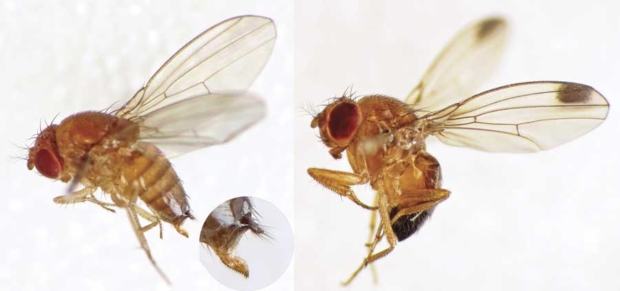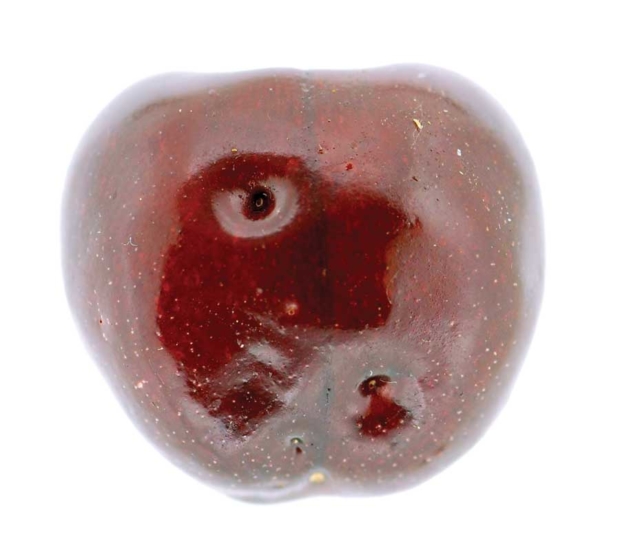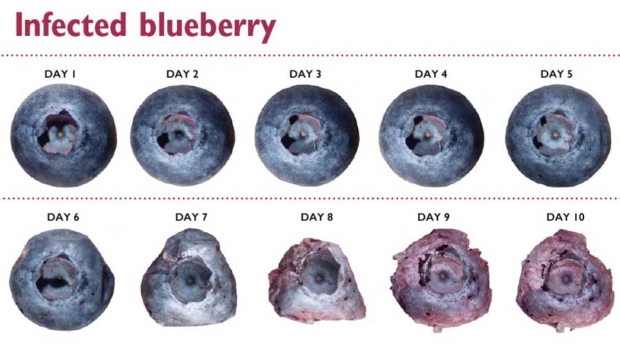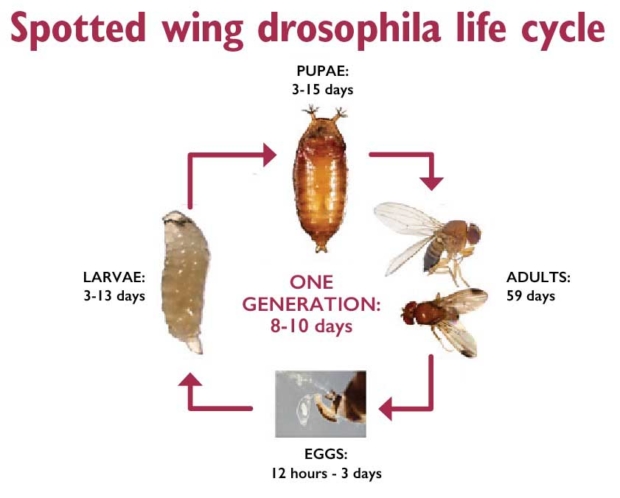
Left: The spotted wing drosophila female attacks both ripe and unripe fruit by penetrating the skin using its large ovipositor with a serrated edge, shown in the enlarged inset below. Right: The male usually has darkened wing tips, which gives the species its name.(Courtesy Martin Cooper)
No one is really sure how or when spotted wing drosophila made the trip across the Pacific Ocean to the United States, but the flies were first discovered in California in 2008.
That same year, they were also discovered in Europe, and in the ensuing years, growers have detected spotted wing drosophila (Drosophila suzukii) in Canada, Mexico, Brazil and across the continental United States.
The pest attacks a range of crops, from blueberries and strawberries to cherries and other stone fruit, as well as wild hosts, and researchers around the world are working to better understand and control it.
In the United States alone, millions of dollars are spent each year on researching this prolific pest in a coordinated approach across multiple research units to address the needs of both conventional and organic growers.
Control?
An international cohort of 14 co-authors published a paper on the global perspectives of the invasion in the September 2015 Journal of Pest Science. It compared and contrasted research findings across areas affected by the insect in Asia, Europe and the United States.
Parasitic wasps are commonly used against pests such as caterpillars, aphids and grubs; however, these bio-control agents are largely ineffective against spotted wing drosophila.
“Spotted wing drosophila larvae have five times the standing immune response against the initial attack of the wasp when compared to other Drosophila species,” said lead author Mark Asplen, an entomologist with the Metropolitan State University Natural Sciences Department in St. Paul, Minnesota.
Researchers in Asia are looking for “specialized candidates for larval attack” in the insects’ original range in Japan, Korea and eastern China. “They are in the quarantine stage being tested to determine what non-target species they also affect. Potential releases are likely several years away,” Asplen said.
Biological control research in Europe has uncovered two parasitic wasp species showing effectiveness against spotted wing drosophila in pupal stages: Pachycrepoideus vindemmiae and Trichopria cf. drosophilae.
Entomologists collected P. vindemmiae using spotted wing drosophila-baited traps in commercial soft fruits and natural habitats in northern Italy and Spain. In laboratory trials, it showed up to 80 percent parasitism on infested raspberries.
It also has a large host range, having been reported to attack more than 60 fly species worldwide.
The second species, T. drosophilae, can be found in Europe, Africa, North America and Australia. It hosts on fruit-eating, pupal drosophila. There is no real information on how well this species performs in natural habitats.
Spiraling risks

The telltale mark of spotted wing drosophila’s ovipositor scars are shown on this cherry. While other fruit flies deposit their eggs into the soft flesh of ripened fruit after harvest, spotted wing drosophila can penetrate through the tougher skin on cherries, blueberries and stone fruits that are still growing on the plant. (Courtesy Martin Hauser, California Department of Food and Agriculture)
“The rapid expansion of their range is one of the reasons why we are so concerned about this pest,” says Dr. Hannah Burrack, an entomology associate professor at North Carolina State University, who is heading up the national small fruits project, a four-year, $7 million study aimed at controlling the pest.
Since 2008, USDA has funded $47.7 million in competitive research grants and Extension programming to combat spotted wing drosophila, many through the Specialty Crop Research Initiative (SCRI), under USDA’s National Institute of Food and Agriculture (NIFA). That effort includes a five-year, $5.4 million project at Oregon State University headed by Dr. Vaughn Walton, which kick-started the efforts in 2010.
What sets SCRI apart from many other federal grant programs is its requirement that grant holders complete applications useful for growers and packers within the life of their projects. Applicants submit proposals reviewed by industry scientists and commodity groups.
“Industry tells us which applications are important and those are the ones who are invited to compete,” said Dr. Thomas Bewick, NIFA’s national horticulture program leader.
The impetus for all this research came from berry growers, who were quick to pick up on a pest impact that wasn’t tolerable, said Herb Bolton, national program leader for NIFA’s division of Plant Protection and Pest Management.

In just 10 days, a spotted wing drosophila larva can destroy a blueberry, feeding on it from the inside after it hatches and before it drops to the ground to transform into a pupa. (Courtesy of Ash Sial, University of Georgia)
Before spotted wing drosophila entered the scene, most commodities had well-established, lower cost production cycles. Now, because one of the few available ways to control the pest is repeated chemical application, production costs have increased considerably.
“The economic impact of this pest is enormous. Annual losses total $718 million,” Bolton said.
The pest poses additional challenges beyond its increasing range. There is zero tolerance for drosophila in the fresh fruit market, and the flies reproduce quickly.
Depending on the temperature, the spotted wing drosophila can mature from egg to adult in just a few days, said Doug Walsh, an agrichemical and environmental extension specialist at Washington State University in Prosser, Washington. Once adult females emerge from the pupa stage, it takes up to 1.5 days to mate and within four days, each female is laying from 70 to 200 eggs.
Unlike other fruit flies, the spotted wing drosophila has a rigid ovipositor, which allows it to pierce the skin of ripening fruit to lay eggs. “By far, raspberries are at the greatest risk, followed by cherries. Blueberries and grapes are less susceptible, because their skins are more resilient,” he said.
Burrack’s project focuses on blueberries and raspberries. A two-year, $2 million project, jointly led by two entomologists — Drs. Ash Sial of the University of Georgia and Mary
Rogers of the University of Minnesota — aims to develop organic and bio-controls for small fruits. The projects are intended to be complementary.
Organic research

A major reason for concern over the spotted wing drosophila relates to the speed at which this pest reproduces. (Courtesy Ash Sial, University of Georgia)
The organic project with Drs. Sial and Rogers has four components. Similar to Burrack’s project, they, too, will be working to build a better bug trap. They also are examining “cultural tactics,” or ways to disrupt the life cycle of the insect.
Among the practices they are looking at are canopy management practices to increase light and or to cool down internal plant temperatures to make an inhospitable environment for the flies.
There is only one effective organic chemical — Entrust — available to control spotted wing drosophila, and the way it is being used will lead to resistance, Sial said. Scientists in his project will be testing its use in combination with seven other compounds and three different adjuvants to find effective alternatives as well as reduce its usage.
They also will be developing extension education, webinars, meetings and on-farm demonstrations designed to keep growers abreast of the latest discoveries these projects make. •
– by Dave Weinstock






Leave A Comment